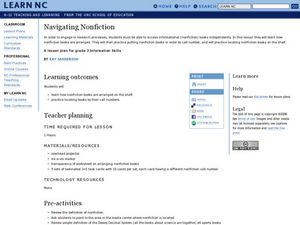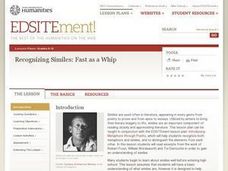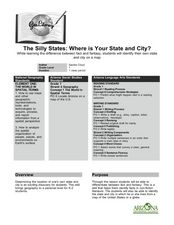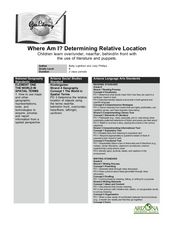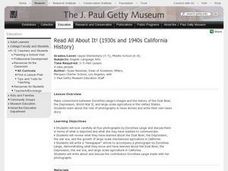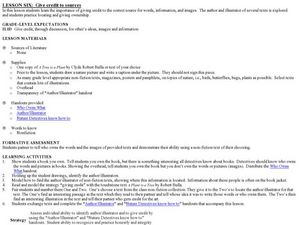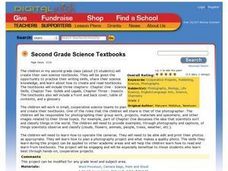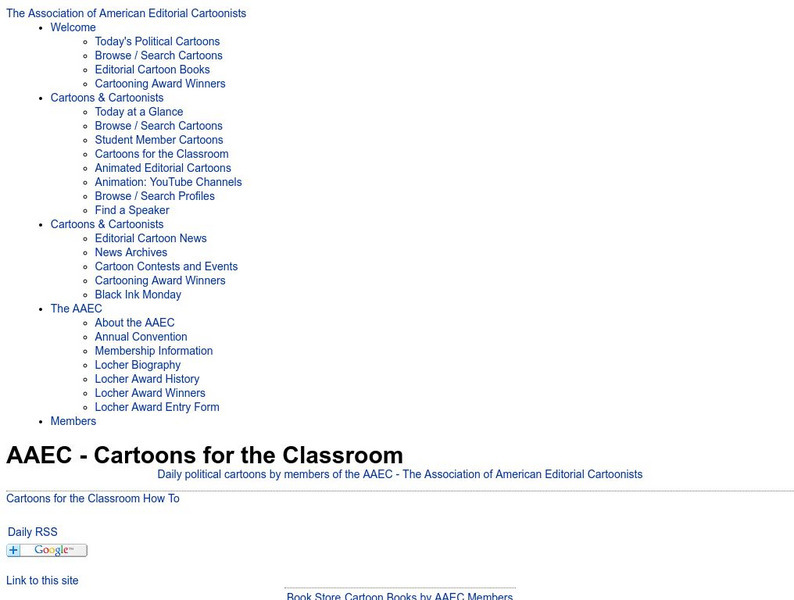Curated OER
Water Cycle Stories
Students explore the water cycle. In this water cycle lesson, students simulate the water cycle by placing an ice cube in a Ziploc bag and observing the changes which occur over time. Students record the mass of the Ziploc bag and record...
Curated OER
Navigating Nonfiction
Third graders explore the arrangement of nonfiction. In this library skills lesson, 3rd graders examine Dewey Decimal classification as they collaborate to locate nonfiction materials in the library/media center.
Curated OER
Recognizing Similes: Fast as a Whip
Pupils review basic knowledge of similes and engage with similes on a more abstract level. In this similes lesson, students define similes and identify examples. Pupils read and analyze the similes used in poetry by Derricotte, Frost,...
Curated OER
Small
Students research visual arts by examining a children's book. In this art identification instructional activity, students discuss the history of art after researching information on the Internet. Students read the book Small which...
Curated OER
Chairs, Chairs, Everywhere...
Students generalize about a variety of designs of inventions. Students respond to a variety of visual designs. Students become aware of the multitude of design variations in everyday objects.
Curated OER
The Silly States: Where Is Your State and City?
First graders read The Scrambled States of America and discuss whether it is real or fantasy as compared to the United States. For this geography lesson, 1st graders identify their city or state on a map and work in groups to color the...
Curated OER
Where Am I? Determining Relative Location
Pupils use position words to describe where their teacher is sitting and read a story that makes use of position words. In this spatial lesson plan, students make a stick puppet and play Simon Says focusing on using position words in the...
Curated OER
Honey ! I Blew Up The Bee!
Second graders complete a variety of bee-themed activities. They consider the importance of honeybees in food production, conduct Internet research, prepare foods using honey, complete puzzles and compile a portfolio of their work.
Curated OER
Read All About It! Events and People of the 1930s and 1940s That Shaped California and the Nation.
Students look carefully at four photographs by Dorothea Lange and discuss them in terms of what is depicted and what she may have wanted to communicate. They review what they learned about the Dust Bowl, the Depression, the war era, and...
Curated OER
A Funny Happened on the Way to Monticello
Third graders examine the Journey of Lewis and Clark and how it relates to Thomas Jefferson and Monticello. They read about, discuss and complete worksheet pertaining to the Lewis and Clark expedition.
Curated OER
A Day In The Life: The Story of a Child Worker in Agriculture."
Students watch a Flash presentation on students working in agriculture in this lesson which is part of a unit. They compare and contrast the experience to their own. Unit links are on this lesson page.
Curated OER
Give Credit to Sources
Third graders practice referencing material. In this giving credit to sources lesson, 3rd graders explore ownership of words and images by drawing and labeling a picture then problem solving how to identify the author.
Curated OER
Images As Persuasion
Students examine how images can persuade or influence an audience. They discover how the message an image sends depends on the perspective of the audience.
Curated OER
Second Grade Science Textbooks
Second graders create their own science textbooks. They work in small, cooperative science teams to plan and create their textbooks. In addition, they photograph their group work, projects, materials and specimens, and other images.
Newspapers in Education
Ni Eonline: Cartoons for the Classroom: Lessons Library
Newspapers in Education and the Association of American Editorial Cartoonists publish simple, inventive lesson plans and ideas for classes in editorial cartooning, caption writing, and news analysis. Lessons include "cartoon blanks" that...

